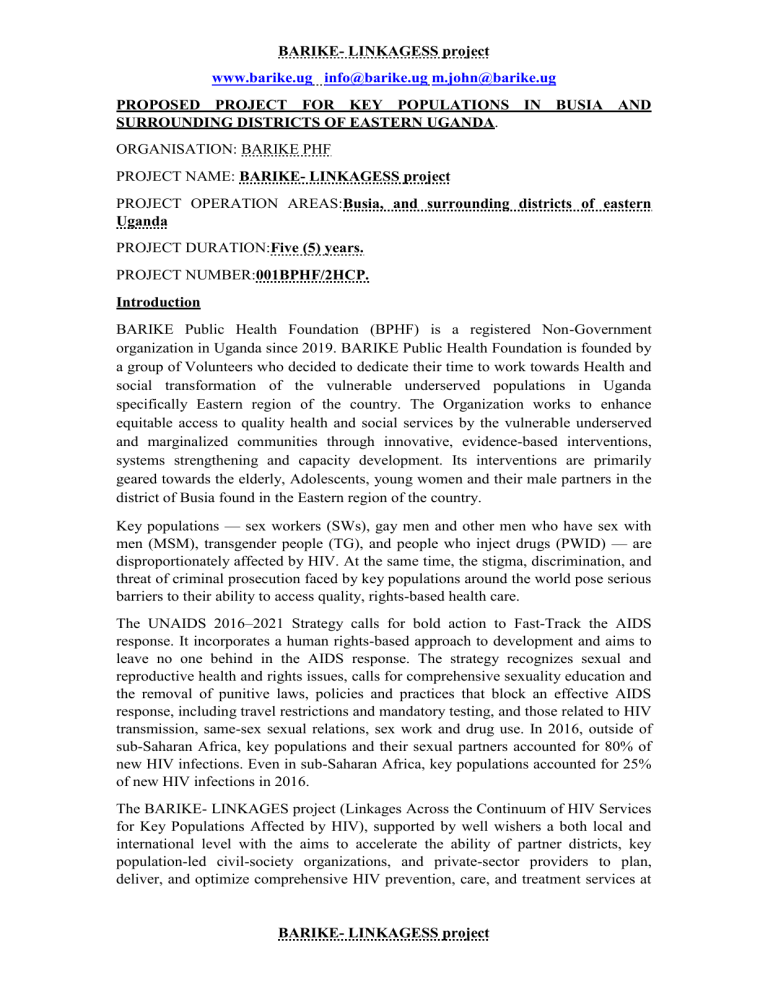
BARIKE- LINKAGESS project www.barike.ug info@barike.ug m.john@barike.ug PROPOSED PROJECT FOR KEY POPULATIONS IN BUSIA AND SURROUNDING DISTRICTS OF EASTERN UGANDA. ORGANISATION: BARIKE PHF PROJECT NAME: BARIKE- LINKAGESS project PROJECT OPERATION AREAS:Busia, and surrounding districts of eastern Uganda PROJECT DURATION:Five (5) years. PROJECT NUMBER:001BPHF/2HCP. Introduction BARIKE Public Health Foundation (BPHF) is a registered Non-Government organization in Uganda since 2019. BARIKE Public Health Foundation is founded by a group of Volunteers who decided to dedicate their time to work towards Health and social transformation of the vulnerable underserved populations in Uganda specifically Eastern region of the country. The Organization works to enhance equitable access to quality health and social services by the vulnerable underserved and marginalized communities through innovative, evidence-based interventions, systems strengthening and capacity development. Its interventions are primarily geared towards the elderly, Adolescents, young women and their male partners in the district of Busia found in the Eastern region of the country. Key populations — sex workers (SWs), gay men and other men who have sex with men (MSM), transgender people (TG), and people who inject drugs (PWID) — are disproportionately affected by HIV. At the same time, the stigma, discrimination, and threat of criminal prosecution faced by key populations around the world pose serious barriers to their ability to access quality, rights-based health care. The UNAIDS 2016–2021 Strategy calls for bold action to Fast-Track the AIDS response. It incorporates a human rights-based approach to development and aims to leave no one behind in the AIDS response. The strategy recognizes sexual and reproductive health and rights issues, calls for comprehensive sexuality education and the removal of punitive laws, policies and practices that block an effective AIDS response, including travel restrictions and mandatory testing, and those related to HIV transmission, same-sex sexual relations, sex work and drug use. In 2016, outside of sub-Saharan Africa, key populations and their sexual partners accounted for 80% of new HIV infections. Even in sub-Saharan Africa, key populations accounted for 25% of new HIV infections in 2016. The BARIKE- LINKAGES project (Linkages Across the Continuum of HIV Services for Key Populations Affected by HIV), supported by well wishers a both local and international level with the aims to accelerate the ability of partner districts, key population-led civil-society organizations, and private-sector providers to plan, deliver, and optimize comprehensive HIV prevention, care, and treatment services at BARIKE- LINKAGESS project BARIKE- LINKAGESS project www.barike.ug info@barike.ug m.john@barike.ug scale that reduce HIV transmission among key populations and extend life for those who are HIV positive. BARIKE- LINKAGES is partnering with Busia district and the surrounding districts of eastern Uganda. The BARIKE- LINKAGES approach is summarized in the cascade of services for HIV prevention, diagnosis, care, and treatment. The Cascade is aligned with the United Nations 95–95–95 objective—by 2030, 95% of all people living with HIV will know their HIV status, 95% of people diagnosed with HIV infection will receive sustained antiretroviral therapy (ART), and 95% of people receiving ART will have viral suppression. PROJECT AREAS AND PROJECT ELEMENTS 1. Population Size Estimation and Mapping 1. National-level population size estimation and mapping 2. Local-level population size estimation and mapping 3. Hotspot-level population size estimation and mapping 4. Plan the program using mapping and size estimation data 2. Key Population Engagement and Empowerment 1. Develop staffing of programs and teams by key population members 2. Establish drop-in centers 3. Support key population groups through capacity development and organizational strengthening 4. Foster oversight of clinical services and other services by the key population community 3. Structural Interventions 1. Establish a system to respond to incidents of violence, abuse, harassment, and discrimination against key population members 2. Identify, design, and implement strategies for violence prevention with the key population community and with power-holders 3. Develop strategies for reducing stigma in health-care settings 4. Peer Outreach 1. Map or validate key populations and set targets for outreach 2. Develop or adapt micro-planning tools 3. Recruit peer outreach workers 4. Train peer outreach workers BARIKE- LINKAGESS project BARIKE- LINKAGESS project www.barike.ug info@barike.ug m.john@barike.ug 5. Implement and manage peer outreach 6. Provide advanced training and support for professional development 7. Support retention in care of HIV-positive key population members 5. Clinical Services General considerations for establishing and providing clinical services: 1. Assess current services and the service needs of key populations 2. Organize effective, high-quality, available, and accessible services 3. Organize referral systems and track referrals Considerations for specific clinical services: 4. Condom and lubricant promotion 5. STI services 6. Pre-exposure prophylaxis (PrEP) 7. Post-exposure prophylaxis (PEP) 8. HIV testing services (HTS) 9. Antiretroviral therapy (ART) 10. Prevention, screening, and management of common infections and co-infections 11. Harm reduction for people who inject drugs 12. Other drug and alcohol dependence 13. Sexual and reproductive health services, including family planning, and post abortal care. 14. Management of sexual violence 15. Mental-health care 6. Project Management 1. Contract, hire, and train staff 2. Establish and implement policies and procedures on data safety, Confidentiality, and ethics 3. Establish systems for supportive supervision and technical support 7. Monitoring and Data Use 1. Develop or adapt data-collection tools 2. Ensure the quality of data collection, analysis, and reporting 3. Regularly review and analyze data and use for programming BARIKE- LINKAGESS project
